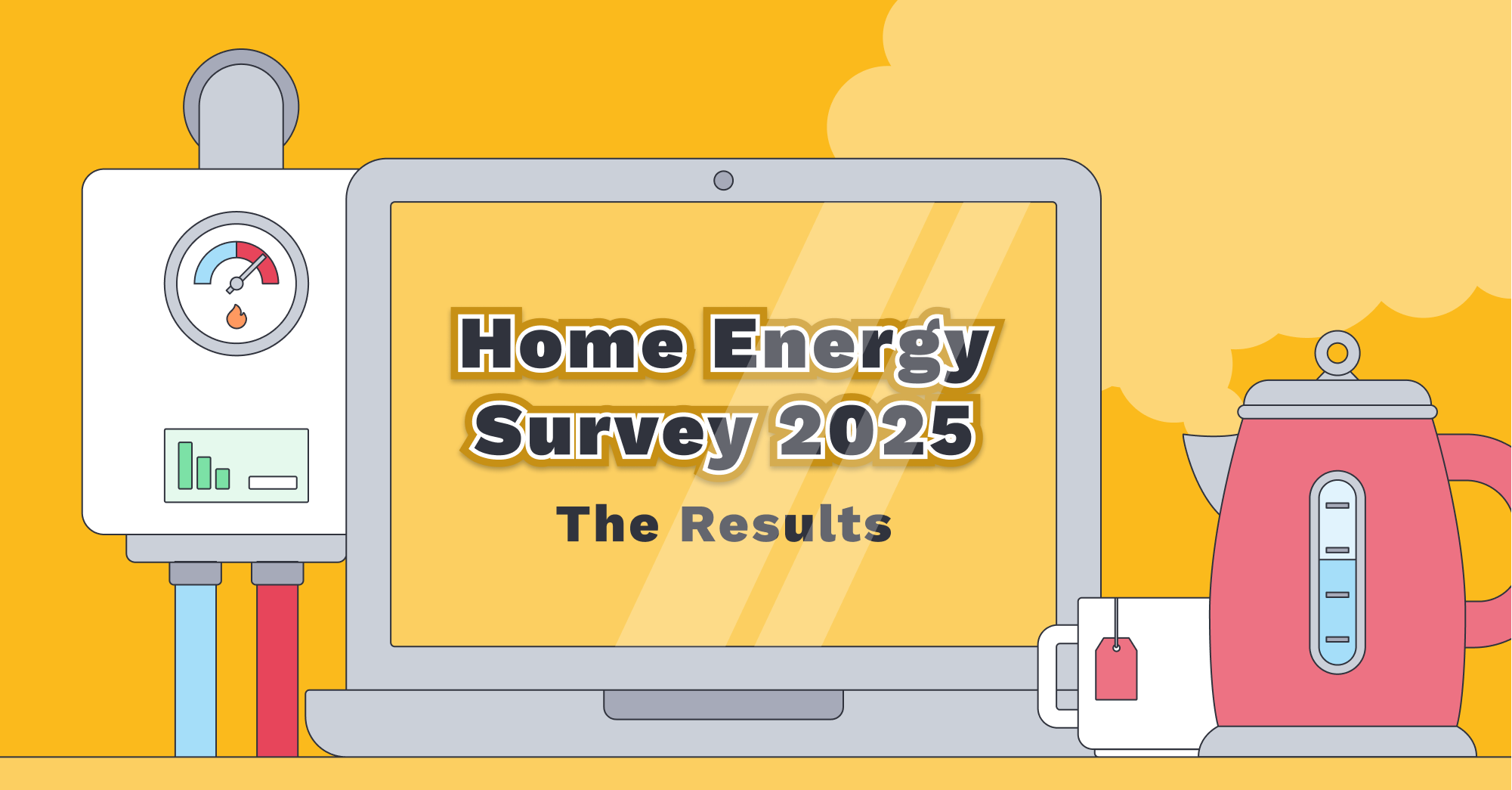We’re excited to share our annual Home Energy Survey (2025) with you, marking the fifth year in a row we’ve been able to give you a peek into what’s happening in the energy market here in Northern Ireland.
Based on over 1,100 responses, this year’s survey highlights key trends and challenges that households continue to face. While there has been some relief from steep energy price increases, the cost-of-living crisis is still affecting many, with significant impacts on how people are managing their energy use and costs.
Let’s take a closer look at the survey findings and see how the energy landscape is evolving for consumers like you.
Key Findings:
- Energy Bills: 61% of respondents report that their energy bills continued to increase over the last year. Whilst most people continue to face rising energy costs, this is down from 90% in 2024, indicating a slowing pace of price hikes.
- Increased Cost: The average increase in annual bills was £357 – lower than the £558 reported in 2024 and £679 in 2023. Over the past three years, households have faced an average increase in energy bills of £1,594.
- What about those who have lower bills: 10% of respondents saw their bills decrease and 14% reported no change. With prices remaining high this may be due to a change in energy use in the home or switching energy supplier. Users of Power to Switch who changed suppliers saved an average of £421.
- Difficulty Paying Bills: Almost half of respondents reported difficulty paying their energy bills, down from 61% last year and 67% in 2023. This may reflect some easing in energy prices over recent months and initiatives like the Utility Regulators’ Customer Charter, which ensures suppliers offer additional support for those in debt or hardship.
- Pay as You Go Customers: Half of customers on keypad (prepaid) meters reported running out of credit and being unable to afford an immediate top-up – nearly unchanged from 2024 (54%). This highlights ongoing issues with self-disconnection[1], particularly significant in NI where a large share of customers (approx 45%) are on a pre-pay tariff.
- Top Up Problems: Among those people who had run out of credit and were unable to top-up, 1 in 5 experienced the issue once, while over half faced it 2–5 times during the year. Alarmingly, 17% reported it happening six or more times.
- Oil Purchasing Habits: Among the 55% of respondents who heat their homes with oil, only 15% reported going without a top-up – down from 22% in 2024 and 30% in 2023. Oil prices have now fallen to their lowest level since September 2021 so may explain this improvement.
- Topping Up Less: However, 37% continued to limit their oil fills, reflecting ongoing financial pressure. Encouragingly, 45% of oil users shopped around a lot more for prices before ordering a delivery.
“I have no other means to heat the house, we have no fireplace, only electricity and oil heating. If prices increase other things like food would have to reduce.”
“I am housebound and my disability makes me very sensitive to draughts. If I am unable to keep the heating on, my health deteriorates rapidly and I suffer physically as a result.”
How People Are Coping:
- The shock of energy bills spiking over recent years has left people more aware of their energy use. Over 80% of households are now more cautious about how much energy they use in the home.
- Half of respondents reported turning off their heating despite feeling cold. For many people this will not be an issue and may mean keeping on an extra layer of clothing, but a cold home can pose a serious health risk for vulnerable groups such as older adults or those with long-term health conditions.
- Seeking warmth elsewhere: nearly 1 in 5 people said they stayed longer in a public place, such as work or a community centre to save on heating at home. One respondent mentioned, “[I] Don’t work from home. It costs too much in home heating.”
- When asked about their fears should energy prices continue to rise, comments from respondents reflect their ongoing worry:
“At 85 I would turn heat and non necessary electricity off and go to bed.”
“I’m afraid I’d have to spend more time in an unheated house.”
“I have 3 children, I want them to feel safe and warm in their home.”
“Pain. I have severe arthritis and the cold leaves me in a lot of pain it’s a struggle.”
Looking Ahead: Planned Home Energy Improvements
- It is worrying, and perhaps reflects the limited financial or Government support that almost half of people (48%) do not plan any energy efficiency improvements to their home over the next year.
- The most common energy efficiency measure people plan to introduce is switching to energy efficient light bulbs (17%), installing loft or wall insulation (10%), or installing smart thermostat or heating controls (8%).
“I’m already looking into better insulating the house to reduce the cost of heating.”
“If I can’t keep my house warm it’s susceptible to damp and mold which harms my health.”
Switching Energy Supplier
- If a person has never switched or if they have not switched in a year or more, then switching is the quickest and easiest way to reduce energy bills. People who have switched their energy supplier with Power to Switch over the last year saved on average £421.
- Using Power to Switch also means that the main barriers for people not switching – lack of confidence in finding the best deal (28%), or confusion around unit rates and standing charges (22%) – are tackled. People can be sure they are getting an independent and accurate view of all energy deals available and can switch immediately.
“I am a first time buyer and these prices scare me for the future. I have had my house since September and electricity has already increased a lot.”
What People Want From Their Energy Deal
Many people still are unsure about how energy prices, including price changes, are calculated and how to assess the overall value of a deal. However, it is clear from the Power to Switch Home Energy Survey what consumers want from their energy supplier:
- A well-priced, competitive discount tariff that will apply for the entire period of their contract term (52%)
- Online Account Management or App to track usage and make payments or top up (33%)
- Customer Service that is easy to access and can deal with any queries or issues quickly (31%)
It is interesting that these customer priorities are greater than the importance placed uoon the payment options suppliers provide (21%), cashbacks or other perks and promotions on offer (20%) and well ahead of a focus on green / renewable sources (9%), low exit fee (7%) or awareness of the energy supplier (6%).
A call for greater transparency and consumer support
To us, this year’s survey highlights the need for clearer pricing and more support for vulnerable households, especially when it comes to energy efficiency.
“While we’re seeing some positive trends, many households still struggle to manage rising energy costs,” said Power to Switch Director Aodhan O’Donnell. “It’s crucial more support is made available to help people make their homes energy efficient as well as empowering consumers to take control of their energy bills.”
“In addition, it is clear people want suppliers to provide competitive deals, which are easy to understand and can provide them with confidence on how much their energy bills will actually cost – the spikes and uncertainty in energy prices over recent years has really hurt consumers.”
Saving more money switching
In short, it’s a tough time to be an energy user and bill-payer. Things are improving, but they’re not reversing, and that means that consumers should think about controlling what they can – and oftentimes that’s their energy usage and what deal their on.
See if you can save today by comparing your energy deal. On average, we save customers £421 a year from their bills – so try it yourself.
[1] Self-disconnection occurs when a household using a prepayment meter loses access to energy because they cannot afford or are unable to top up.






